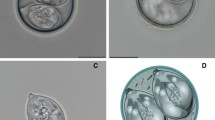Abstract
In the present study we describe a Nosema infection in a Phyllotreta nigripens population. The parasite was identified as Nosema phyllotretae. The spores are oval, 3.97±0.47 μm (2.85–4.75) in length and 2.19±0.36 μm (1.90–2.85) in width. The polar filament has commonly 14 coils. The spore wall is 138–200 nm thick and made up of a clear endospore (88–140 nm) and a uniform exospore (40–70 nm). The polar filament measures 100–125 nm in diameter in the mature spirals. The polaroplast is thin lamellar. This study presents P. nigripens as a new host for N. phyllotretae and a second infection locality in Turkey.




Similar content being viewed by others
References
Aslan İ, Özbek H (2000) Phyllotreta (Coleoptera, Chrysomelidae, Alticinae) species, their biology and damage in some vegetables in Cruciferae family. In: Proceedings of the 3rd vegetable symposium, 11–13 September 2000, Isparta, pp 203–207. (Turkish, with English summary)
Aslan İ, Özbek H, Konstantinov A (2003) Flea beetles (Coleoptera, Chrysomelidae) occuring on Amaranthus retreflexus L. in Erzurum province, Turkey, and their potential as biological control agents. Proc Entomol Soc Wash 105:441–446
Aslan İ, Özbek H, Warchalowski A (2004) Five new records, new localities and new host plants for the Turkish flea-beetles fauna (Coleoptera: Chrysomelidae: Alticinae). Entomologica Fennica 15:138–141
Karnovsky MJ (1971) Use of ferrocyanide-reduced osmium tetroxide in electron microscopy. In: Proceedings 14th Annual Meeting American Society Cell Biology, p 146
Larsson R (1986) Ultrastructure, function, and classification of microsporidia. Progress Protistol 1:325–390
Larsson R (1989) Identification of microsporidian genera (Protozoa, Microspora)—a guide with comments on the taxonomy. Arch Protistenkd 136:1–37
Larsson R (1999) Identification of microsporidia. Acta Protozool 38:161–197
Myers JH (1988) Can a general hypothesis explain population cycles of forest lepidoptera? Adv Ecol Res 18:179–242
Pilarska D, Linde A, Goertz D, McManus M, Solter L, Bochev N, Rajkova M (2001) First report on the distribution of microsporidian infections of browntail moth (Euproctis chrysorrhoea L.) population in Bulgaria. J Pest Sci 74:37–39
Reynolds ES (1963) The use of lead citrate at high pH as an electron-opaque stain in electron microscopy. J Cell Biol 17:208–212
Sommer G (1981) Biology and parasites of Phyllotreta spp. (Coleoptera, Halticinae). Final report of work, Commonwealth Institute of Biological Control, European Station, Delemont, Switzerland, p 45
Spurr AR (1969) A low-viscosity epoxy resin embedding medium for electron microscopy. Clin Microbiol Res 3:197–218
Tanada Y, Kaya HK (1993) Protozoan infection: apicomplexa, microspora. In: Insect pathology, Academic, San Diego, pp 414–457
Toguebaye BS, Bouix G (1989). Nosema galerucellae n. sp., microsporidian (Protozoa, Microspora), parasite of Galerucella luteola Müller (Chrysomelidae, Coleoptera): development cycle and ultrastructure. Eur J Protistol 24:346–353
Toguebaye BS, Marchand B (1984) Nosema couilloudi n.sp., microsporidie parasite de Nisotra sp. (Coleoptera, Chrysomelidae): cytopathologie et ultrastructure des stades de développement. Protistologica 20:357–365
Toguebaye BS, Marchand B (1986) Etude d’une infection microsporidienne due à Nosema birgiin. sp. (Microsporida, Nosematidae) chez Mesoplatys cincta Olivier, 1790 (Coleoptera, Chrysomelidae). Z Parasitenkd 72:723–737
Toguebaye BS, Marchand B (1989) Observations en microscopie électronique à transmission des stades de développement de Nosema nisotrae n.sp. (Microsporida, Nosematidae) parasite Nisotra sp . (Coleoptera, Chrysomelidae). Arch Protistenkd 137:69–80
Toguebaye BS, Marchand B, Bouix G (1988) Microsporidia of Chrysomelidae. In: Petitpierre E, Hsiao TH, Jolivet PH (eds) Biology of Chrysomelidae. Kluwer, Boston, pp 399–416
Weiser J (1961) Die Mikrosporidien als Parasiten der Insekten. Monogr Ang Entomol 17:1–149
Yaman M, Radek R (2003) Nosema chaetocnemae sp. n., a microsporidian (Microspora; Nosematidae) parasite of Chaetocnema tibialis (Chrysomelidae, Coleoptera). Acta Protozool 42:231 −237
Yaman, M, Radek R, Aslan I, Ertürk Ö (2004) Characteristic features of Nosema phyllotretae Weiser 1961, a microsporidian parasite of Phyllotreta atra (Coleoptera: Chrysomelidae) in Turkey. Zool Stud (in press)
Acknowledgements
Dr. Mustafa Yaman was awarded a grant by DAAD (German Academic Exchange Service) (322-A/04/17612) for this study. The authors wish to express their thanks to Prof. Dr. Klaus Hausmann, Berlin, for enabling this study.
Author information
Authors and Affiliations
Rights and permissions
About this article
Cite this article
Yaman, M., Aslan, İ. & Radek, R. Phyllotreta nigripens (Coleoptera: Chrysomelidae), a new host of Nosema phyllotretae (Microsporida) in Turkey. J Pest Sci 78, 239–242 (2005). https://doi.org/10.1007/s10340-005-0100-y
Received:
Published:
Issue Date:
DOI: https://doi.org/10.1007/s10340-005-0100-y




